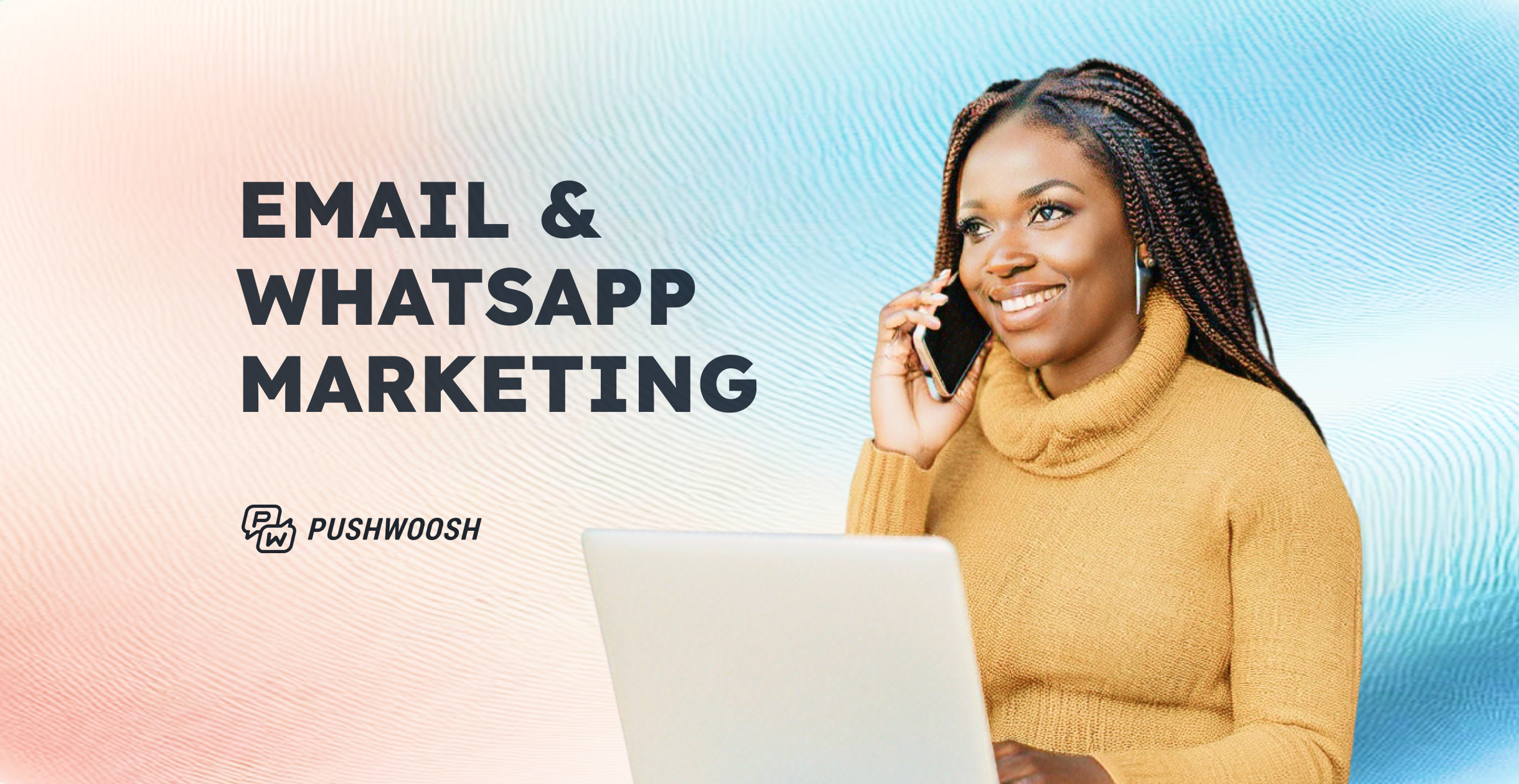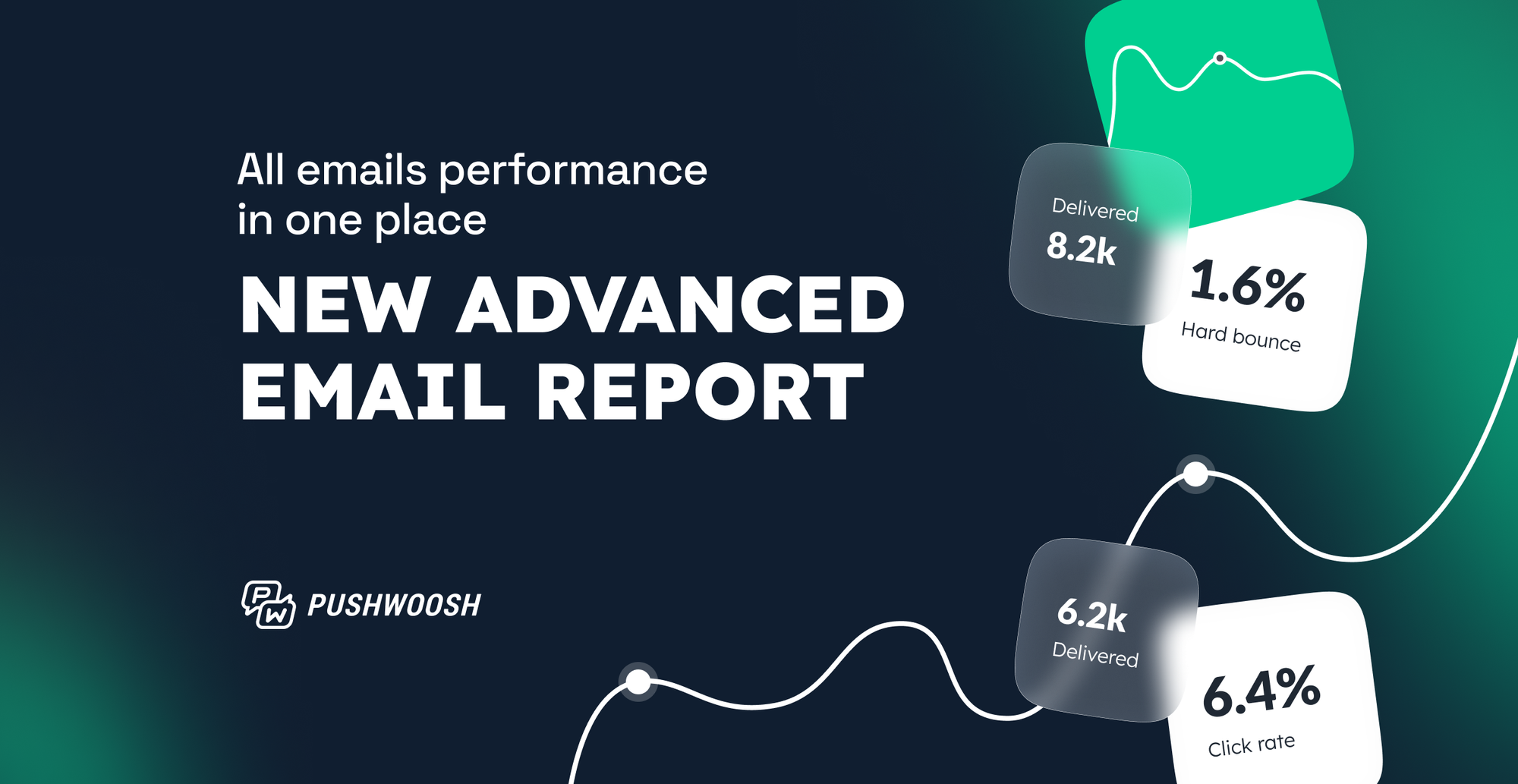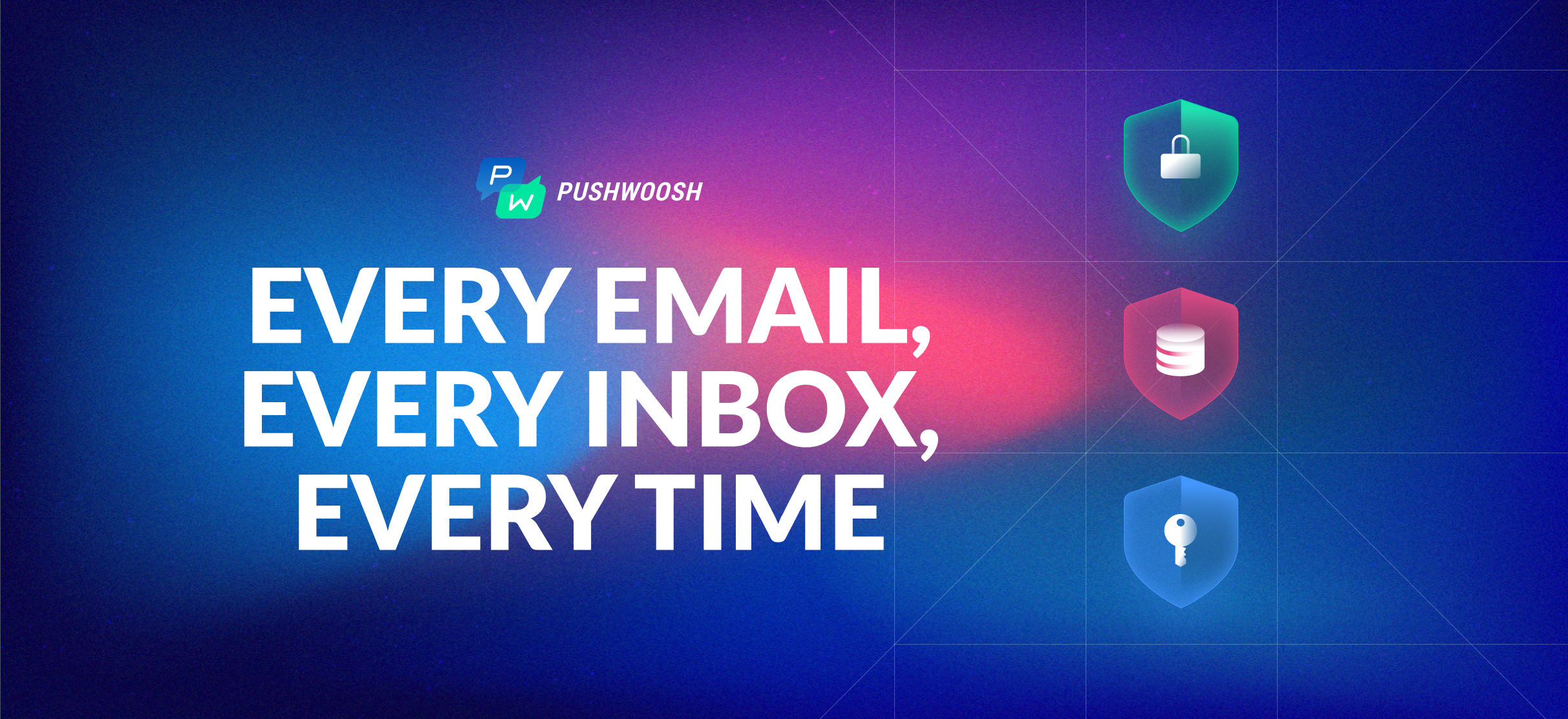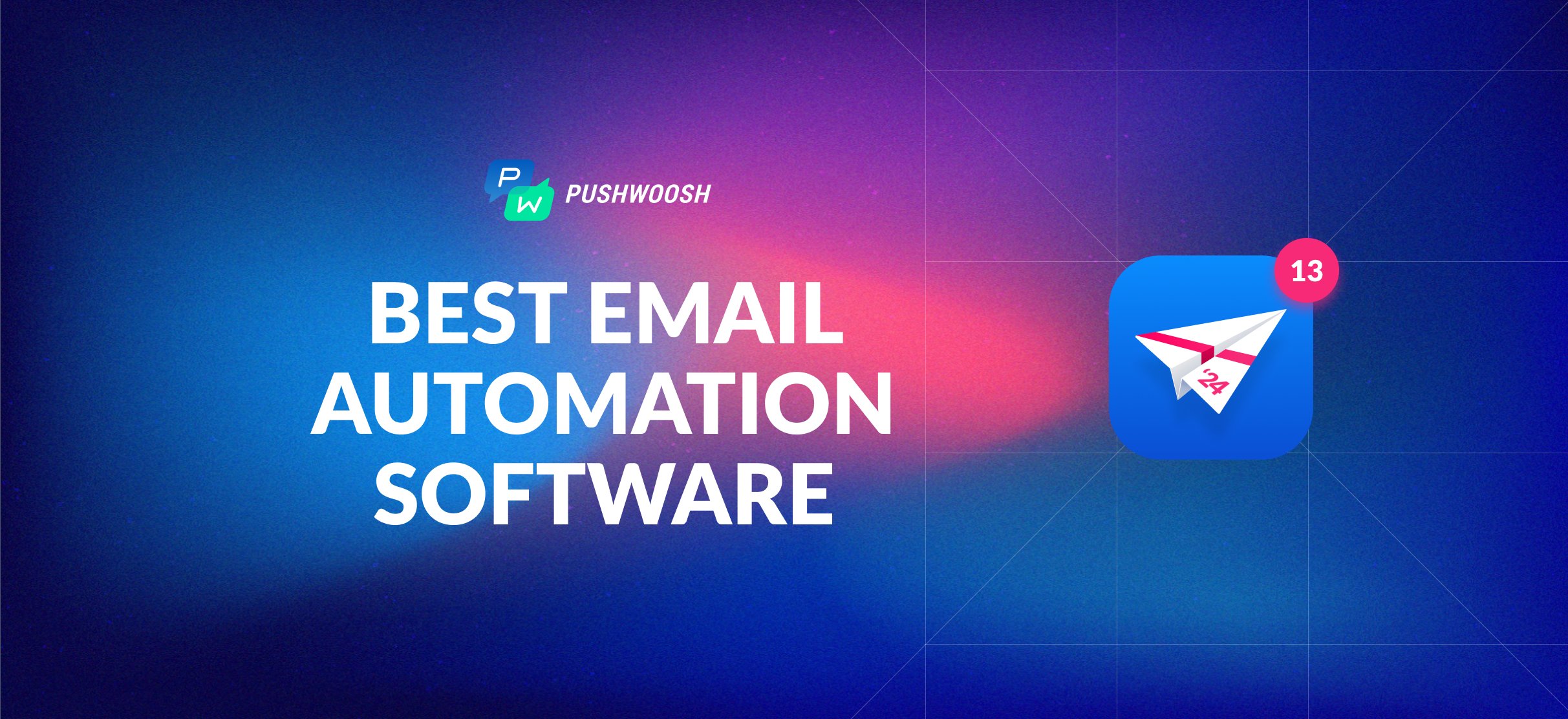Email and WhatsApp marketing: Your communication strategy for 2025
Email and WhatsApp may not be the most obvious channel pairing. Yet, when strategically used side by side, these two can completely reinvent how you approach customer communications.
In this blog post, we review the strengths and weaknesses of both email and WhatsApp marketing, offer tips on when to turn to which channel, and present industry-specific deep-dives to help you build strategies that engage and convert users.
Let’s go!
Email vs. WhatsApp marketing: what makes each one stand out
Depending on your communication strategy and business needs, email or WhatsApp marketing alone can become a powerful tool in building long-lasting relationships with your customers.
Here’s a quick comparison table to make it easier for you to select the right channel:
| Feature | Email marketing | WhatsApp marketing |
|---|---|---|
| User data required | Just an email address is enough. | Requires an active phone number, which some users may be reluctant to share. |
| Interactions | Primarily one-way, though reply functions are available even for automated emails. | Highly interactive with two-way communication enabled for the sender and recipient. |
| Engagement style | Typically one-way, the main goal is to drive the user back to the app/website from the email. | Two-way real-time interactive communication enabling immediate solutions and even check-out. |
| Media | Supports text, images, and videos. Files can be shared via links. | Supports text, images, videos, voice messages, and document attachments. |
| Compliance | Strict regulations such as GDPR & CCPA; requires user opt-ins and data privacy compliance. | Same as email + required strict adherence to WhatsApp Business Policy and user consent. |
| Security | Depends on the email provider & domain security settings. | End-to-end encryption for all communications. |
| Open rates | Generally low, with 20-30% being an average for most industries. | Super high, averaging 98% in some industries. |
| Best used for | Long-form content, such as newsletters & onboarding campaigns. | Customer support and other two-way communications. |
And now, let’s take a closer look at what each channel has to offer.
Email marketing: the king of long-form communications
Email is definitely among the most popular digital marketing channels for businesses. And for a good reason, too!
The main advantages of email marketing
It’s cheap: email is among the most cost-effective marketing channels, which means that you get maximum results from a minimal investment, with email marketing platforms readily available from as little as $13/mo.
It brings high ROI: marketers can hope for up to 4000x in return on investment, earning as much as $40 for every dollar spent on email campaigns.
It’s simple: setting up an automated email marketing campaign doesn’t require any coding or design skills while allowing for precise personalization and segmentation of your target audience.
It’s cross-channel: Email integrates seamlessly with other channels, such as push notifications, in-app messages, or SMS.
It’s universal: everybody has an email address these days, which means that your customer base is not limited to any specific platform or region!
When to use email marketing?
Email is a long-form medium. Which means that it shines especially bright when used to send extended and/or regular communications. Our advice is to use email marketing for:
Long-form content, such as regular newsletters or detailed product updates. For example, if you run an e-commerce business, a monthly newsletter featuring the latest promotional offers is hard to ignore!
Product onboarding series (which is also long-form, by the way). For example, an email sequence guiding users through setup, benefits, and use cases helps them get the hang of your app faster. In-app user onboarding is a different story.
Triggered communications that respond to specific user actions. For example, a user who abandons their cart may trigger an email with a special offer or reminder. Triggered emails deliver timely, personalized messages that can significantly increase engagement and conversions.
Re-engagement and re-activation campaigns when all other means have failed. For example, an email with a special discount on the new game-changing feature can drive back the users who have recently stopped engaging with your app.
Transactional communications for receipts, order confirmations, or shipment statuses. For example, a detailed receipt email featuring order information and estimated delivery dates sent immediately after a purchase can significantly boost your user experience.
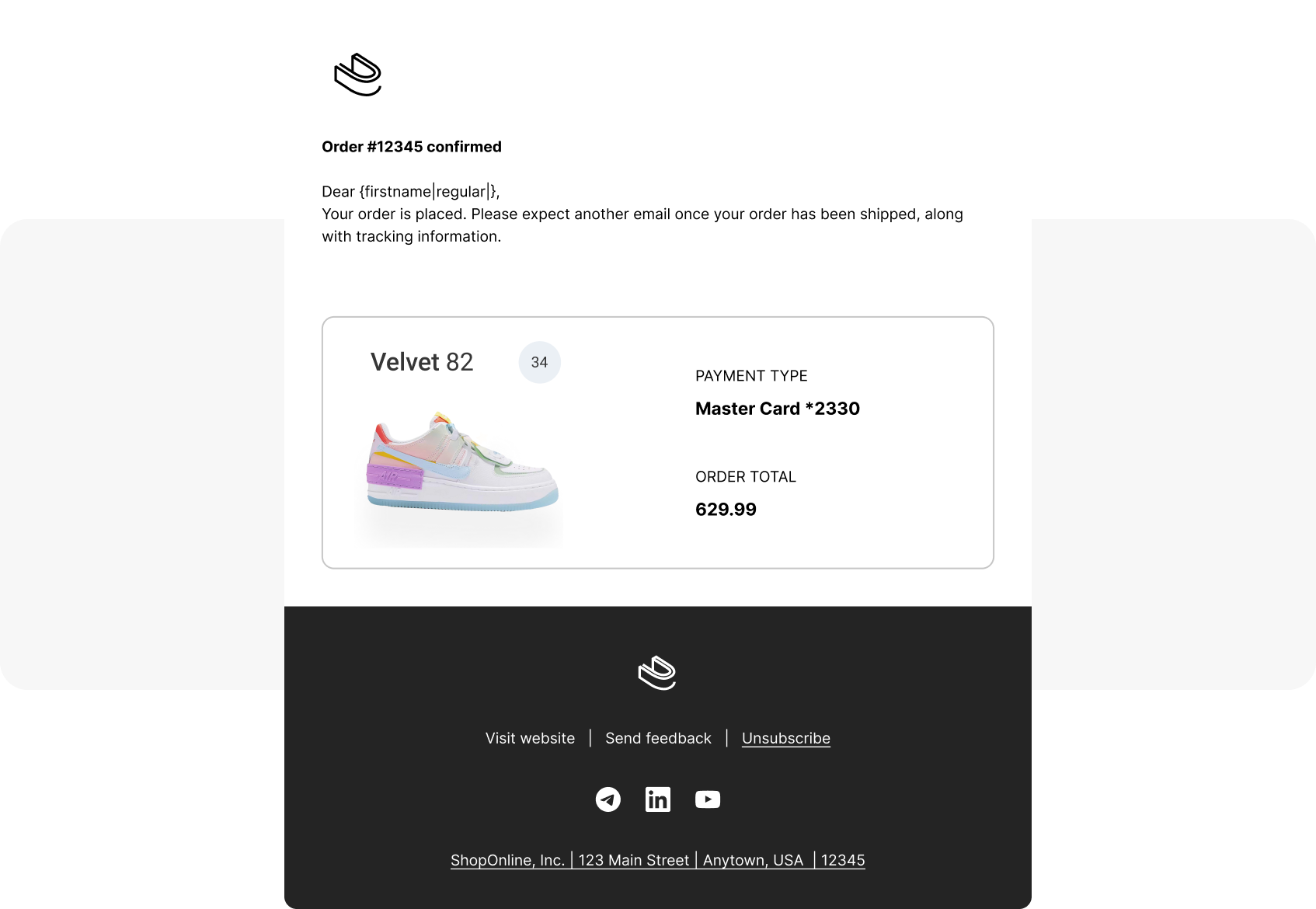
Email marketing best practices
It may be tempting to set up an attractive newsletter, buy a contact base, and call it a day. It won’t, however, be email marketing. It will be a newsletter with a low CTR and a high unsubscribe rate that will most likely land you in spam.
Instead, you should think about email marketing as a channel, the same way you treat social media or your website.
It needs to have a purpose, a clearly defined target audience, and a plan. So, the right tool to enable quality automation and segmentation of your email marketing campaigns is a must.
Automate it with Pushwoosh
Pushwoosh provides a visual email builder that allows marketers to design emails without needing to write any code. The editor supports drag-and-drop functionality and offers a range of pre-designed templates that can be adjusted to match the brand’s tone and layout.
The email automation is integrated within Pushwoosh Customer Journey Builder, with all elements included:
You can build custom logic to define how and when emails should be sent depending on user behavior—such as completing a registration, abandoning a cart, or engaging with a previous email. Campaigns can branch into different scenarios based on these interactions, allowing for targeted follow-ups.
Built-in analytics provide insight into email opens, clicks, delivery rates, and conversions, enabling continuous improvement of your email strategy.
Learn how to easily build email marketing campaigns with Pushwoosh.
WhatsApp marketing: communication strategy re-imagined
While mainly popular for personal communications, WhatsApp is gaining momentum as a business channel as well, with over 200 million monthly active users (MAUs) registered in WhatsApp Business in 2023. It’s also the primary engagement channel in LATAM and MENA regions, so if you’re doing business there – you can’t skip on this one!
Just make sure to keep your WhatsApp communications on point: nobody wants to receive endless notifications from an app in their favorite messaging channel.
Benefits of WhatsApp marketing
It’s cost-effective: While the pricing for WhatsApp marketing campaigns is generally higher than that for email, WhatsApp is still significantly more budget-friendly when compared to its most common alternative—SMS.
It’s engaging: WhatsApp is known for an impressive open rate of nearly 98%. That makes WhatsApp a perfect channel for delivering important product updates or connecting with a user on a deeper level.
It’s secure: WhatsApp’s end-to-end encryption ensures that only the sender and receiver can read the messages, making it one of the best options for delivering sensitive information, such as OTPs.
It’s straightforward: Once contacted via WhatsApp, customers immediately have a reliable way to reach out to you with their requests or feedback, bypassing annoying chatbots or long hold times..
It’s automated: currently, WhatsApp Business allows you to integrate automated greeting and quick replies, and, if you’re using WhatsApp with Pushwoosh, you don’t even need an app to get in touch with customers – if someone replies to your WhatsApp message, their response will appear in Pushwoosh, and you’ll be able to answer right there!
When to use WhatsApp marketing?
The number-one reason for choosing WhatsApp over other marketing channels is that it allows users to reply right back, making it an invaluable ally in your journey towards outstanding customer experience. Consider your audience’s needs and stick to WhatsApp for important updates, such as:
Instant and more time-sensitive messaging, such as order confirmations and delivery updates. For example, a WhatsApp message would be a nice way to inform a customer that their courier is arriving shortly with their order.
Real-time appointment reminders. For example, you can use WhatsApp to connect with a customer 24 hours before the scheduled appointment, giving them an option to confirm or reschedule.
Cart abandonment reminders with personalized offers. For example, a WhatsApp message reminding a user about their abandoned cart, accompanied by a discount code to encourage checkout can perform 10 times better than an email with a similar purpose.
Two-way communications. WhatsApp offers a perfect space for users to ask questions, get product recommendations, or resolve issues in real time, significantly improving your customer support. For example, an e-commerce customer can ask about product availability or get personalized shopping assistance directly via WhatsApp.
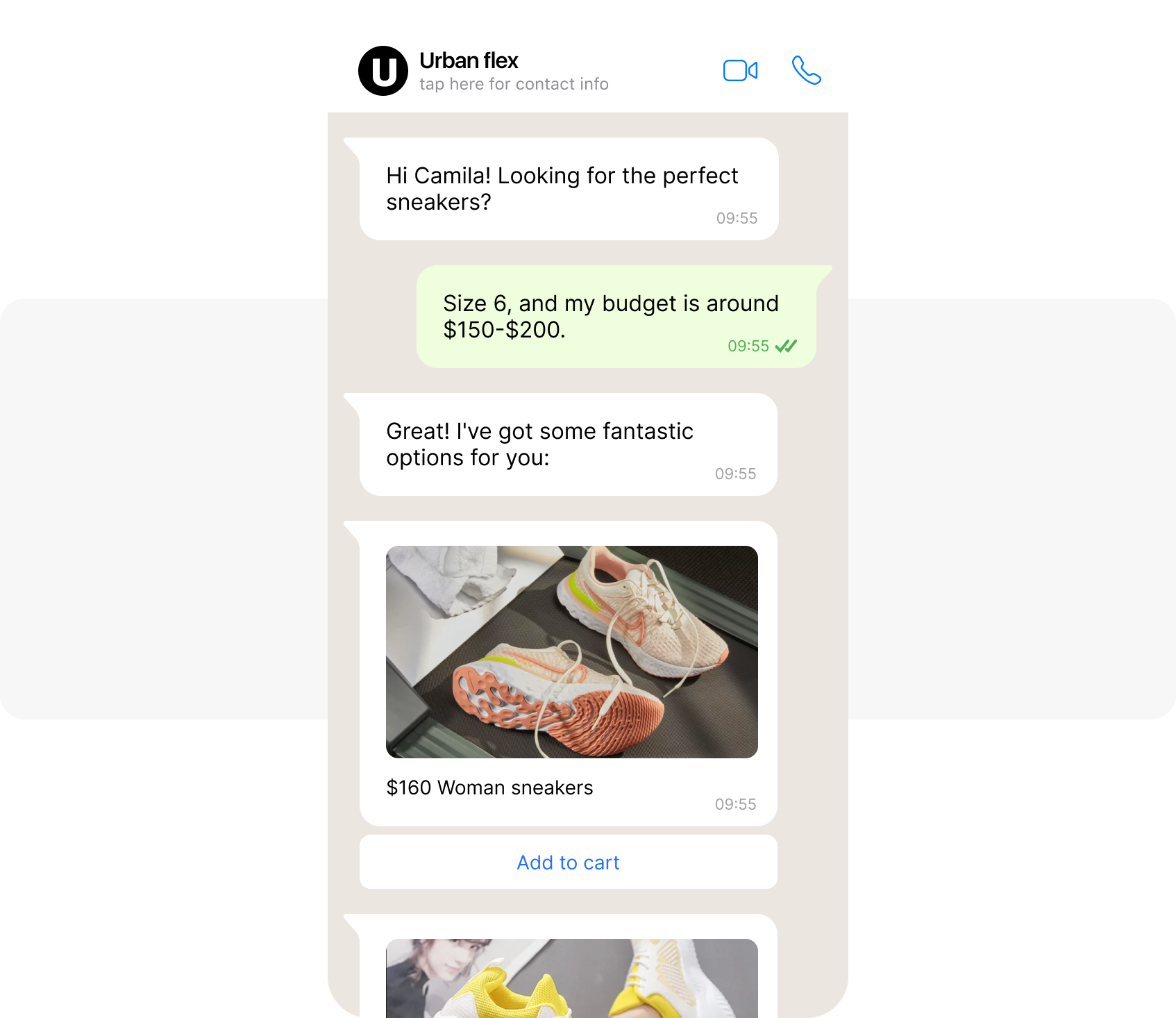
See how to build masterful WhatsApp marketing campaigns with Pushwoosh.
Combining email and WhatsApp for maximum impact
Of course, both email and WhatsApp can be an effective addition to your digital marketing strategy on their own, yet for the most impressive results, it’s best to use them side by side. This way, you can personalize communications per each user’s individual preferences and achieve better results.
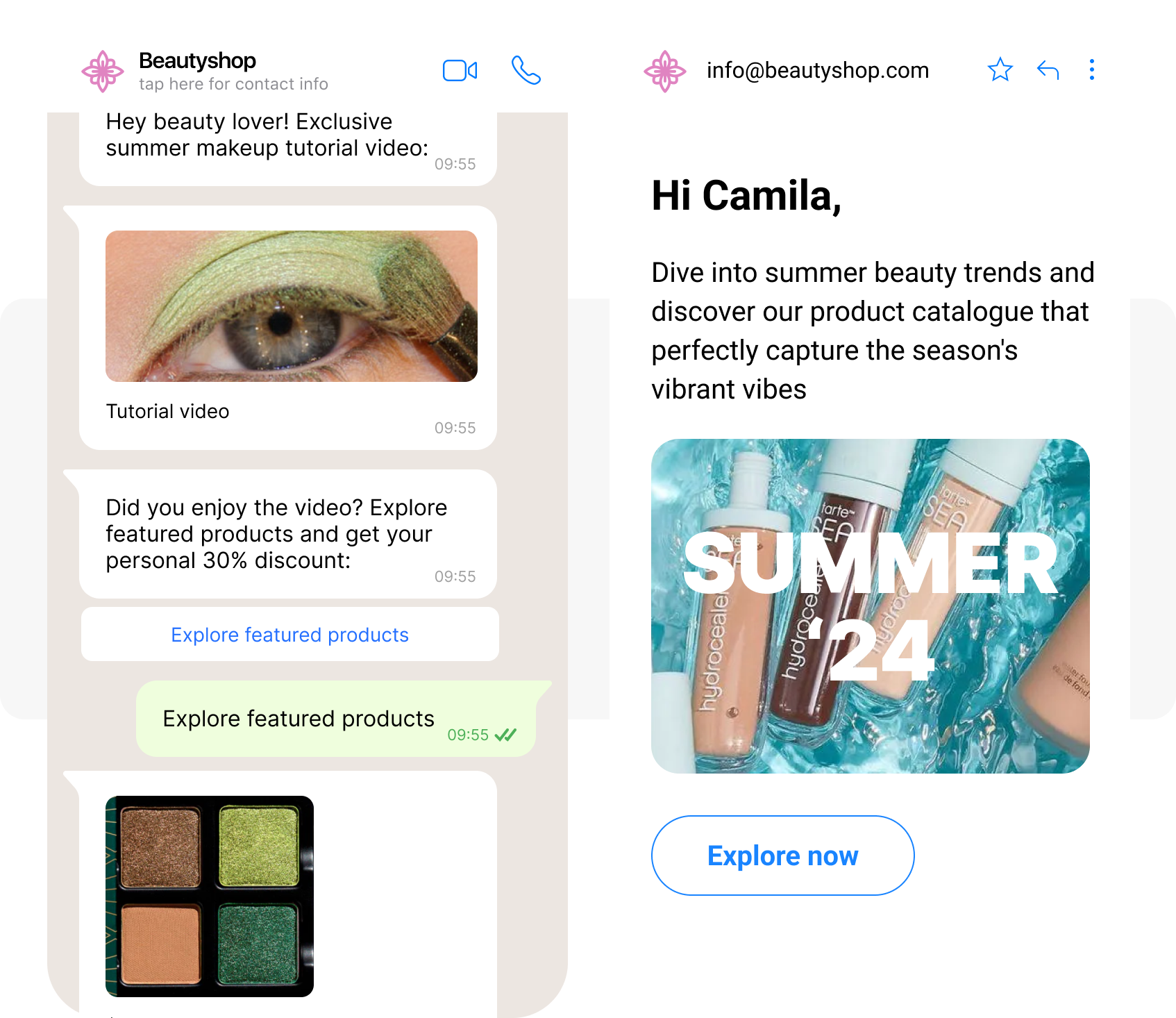
Automate it with Pushwoosh: with us, you can set up cross-channel campaigns with ease by linking a phone number and email to a single user ID, selecting the right channel for each campaign automatically!
Pushwoosh allows you to automate your cross-channel campaigns for email and WhatsApp communications in the same flow. With Pushwoosh Customer Journey Builder, you can:
- Segment audience based on their preferred communication channel;
- Ensure fallback options for failed Reachability Checks;
- Reply to WhatsApp messages directly;
- Build personalized campaigns to highlight each channel’s strengths;
- Further improve your customer experience by introducing additional channels like push notifications, in-app messages, or SMS.
Choosing the channel according to user preference
This one is simple: give your audience a chance to specify their preferred means of communication Then simply use the channel that they have selected.
You can gather this information during user onboarding by directly asking which channel they prefer for notifications and product updates. Then, simply segment users based on the channel of their choice before running a campaign.
This is the most straightforward approach, and it doesn’t require much work from you as a marketer. Of course, it is highly advised to personalize your communications for each channel (e.g. the same re-engagement campaign can be much shorter on WhatsApp and much more detailed in email). But, in a nutshell, the entire campaign setup will come down to choosing the right segmented contacts list per right channel.
But if you can’t reach out to your intended contact by their preferred means of communication?
Choosing the channel according to the reachability check
This one’s particularly important for critical notifications (e.g., security alerts, purchase confirmations, or real-time updates on important events, such as flight changes).
To ensure that the user will always get your communications, it’s a good practice to perform a reachability check that will help you determine whether the user can receive it in the first place.
For example, they might have recently changed their mobile number and haven’t yet updated it in WhatsApp. In that case, email would be more reliable. Similarly, they could have been using their work email and recently changed jobs, so personal WhatsApp communication may be more successful.
For that, you simply need to enable the reachability check feature that will analyze whether the user is actually able to be contacted via the preferred channel and use the spare one for fallback.
Preferring email for cost optimization
Finally, if your onboarding flow doesn’t collect users’ channel preferences and the user seems to be reachable by both channels, we’d recommend sticking to email. It’s simply cheaper that way!
Email and WhatsApp providers charge you differently: email typically involves a single fee per campaign/thousands of emails, while WhatsApp charges for each message/conversation (Meta’s fee + possible provider fees), making it a less cost-effective option.
That’s why it’s better to reserve WhatsApp for time-sensitive communications and two-way conversations, using email for the rest of your marketing activities. This way, you’ll be able to leverage both channels and improve your user experience without spending a fortune.
Below, we’ve gathered some inspiring examples of how you can use email and WhatsApp marketing side by side for optimal results depending on your industry.
Email + WhatsApp in cross-channel campaigns: industry deep-dive
E-commerce and retail
With fierce competition in the industry, e-commerce businesses’ primary goal is to stay in users’ top of mind. Here, delivering highly valuable and personalized content is essential not just to drive immediate sales, but to reinforce that you understand their needs.
For that, leveraging email and WhatsApp in the same campaign can be a game changer! You just need to be smart about it. Here’s how:
Choose email for: Detailed product catalogs, seasonal sale announcements, and loyalty program updates.
Choose WhatsApp for: Follow-ups with personalized recommendations, abandoned cart reminders, and customer service interactions.
This way, both channels will remain relevant to the customer, and you won’t have to address the brand fatigue that commonly occurs when a person is overloaded with communications.
Gaming
New releases and game updates come in thick and fast, so it’s crucial to keep your players engaged. The key to success here is not just to sell the latest in-game features but to build a community with dedicated fans.
Leveraging both email and WhatsApp can significantly boost your chances. Here’s how you could balance the two out:
- Use email for: Sending updates about new features, introducing new skins, or announcing game expansions to re-engage players.
- Use WhatsApp for: Support interactions, such as troubleshooting game issues or answering player queries in real time. As a bonus, you also simplify your QA team’s workload by getting fresh bug reports directly from the community!
This way, you will be building a communications strategy that resonates with gamers without overwhelming them, contributing to the growing gaming community.
Fitness & Wellness
In the fitness and wellness industry, habit formation is central to customer success and retention. Regular engagement and motivational reinforcement can help users stay committed to their wellness plans and achieve their health goals.
Using both email and WhatsApp strategically creates a powerful motivation system that supports these goals:
- Use email for: Sending detailed workout plans & wellness guides, membership renewal reminders, or monthly class schedules.
- Use WhatsApp for:Real-time class updates, appointment reminders, special promotions, and last-minute availability.
This way, email becomes your go-to channel for in-depth knowledge sharing, while WhatsApp is reserved for time-sensitive and transactional communications, making it easy for users to distinguish the two.
Hospitality
In the hospitality industry, guests seek memorable experiences that resonate on a personal level, making thoughtful communication key to deepening guest relationships and loyalty. That’s why, here, your primary focus will likely be on ensuring repeat business and positive word-of-mouth.
Fostering brand loyalty is a great way to start! Using both email and WhatsApp for your communications can make the job a little easier:
- Use email for: Booking confirmations, seasonal promotions, event notifications, or detailed guides with nearby attractions.
- Use WhatsApp for: Real-time updates on reservations, room availability, or special promotions, as well as customer support conversations.
This way, you’ll be able to provide a seamless communication experience that not only meets but exceeds guest expectations, turning a single stay into a lasting relationship and keeping your brand top of mind for future travels.
Automate your email and WhatsApp marketing communications effortlessly with Pushwoosh
Whether you’re sending a detailed newsletter or triggering an instant, two-way conversation, email and WhatsApp marketing work best when they complement—not compete with—each other. With Pushwoosh, it’s never been easier to unite both channels into a single, automated journey that meets your customers where they are.
FAQ
What is email marketing?
Email marketing is a digital marketing strategy that involves sending emails to a targeted group of recipients to promote products, services, or events. It’s a cost-effective and measurable approach to building relationships and driving engagement in the long term.
What is WhatsApp marketing?
WhatsApp marketing is a form of digital marketing that uses the WhatsApp messaging platform to reach and engage with customers. This strategy is especially effective for establishing a personal connection with your audience, as it facilitates one-on-one communication or group chats.
Is WhatsApp marketing free or paid?
WhatsApp Business is a paid solution where you pay for each message that gets delivered to a contact. The pricing is set for a set amount and, in case you exceed the balance, is additionally charged. That’s why we strongly recommend using WhatsApp for campaigns that anticipate high ROI, sticking to more cost-effective solutions, like email marketing or push notifications, for the rest of your communications.
Is WhatsApp marketing better than email marketing?
Both WhatsApp and email are solid channels for communicating with your customers. Each has its pros and cons, so it’s important to select the channels with strategic goals in mind. WhatsApp generally has higher open rates but is also much more expensive when compared to email. Email, in turn, allows sharing more content in a single message and has the potential to reach a wider audience.

